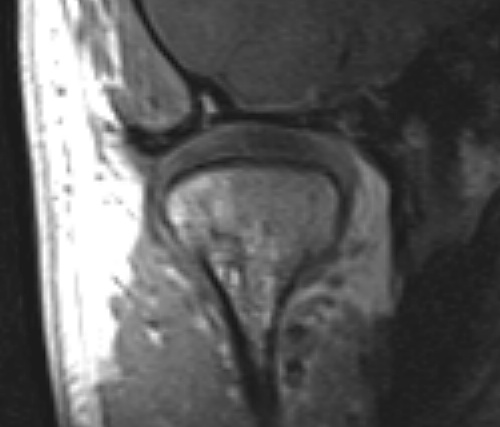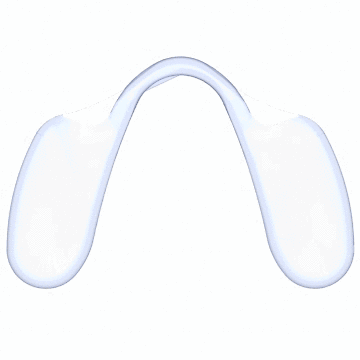As the name already implies, the common understanding often times consists of a reduction of the problem to the jaw joints. Joint x-rays or MRI’s tend to be the main diagnostic means and if they look strange, the cause of the problem seems to be located. If not, the disorder must be of a mental nature.
However, pain rather rarely emanates from the jaw joints themselves, but most commonly from chronically tight muscles. Sometimes, pain is referred from muscles into the area of the TMJ by means of so called „Myofascial Triggerpoints“. If so, it tends to become even harder to sort things out!
Dentists may know about chronic muscle tightness, but they are not taught in school how to diagnose and quantify it and, more importantly, how to deal with it in a meaningful therapy. It is much easier to think of a patient functioning like a dental articulator which you can move in a predictable manner around its hinge axis. But articulators have no muscles and no proprioception and you cannot push them out of alignment when moving them with your hand as may happen when moving a patient’s mandible in that manner. The result may then be a bite position which causes the patients chewing muscles stress to work in.
But stressed muscles are tight muscles and tight muscles pull their ends together, resulting in a chronic compression of the joint they move. In the course of months and years, this compression, when it occurs in the TMJ’s, may lead to changes. The disk may be displaced, causing clicking during movement and limiting the range of motion. TMJ’s may even change their shape in response to chronic joint compression and in the end patients may hardly be able to open their mouth or their joints may produce grinding sounds or pain when trying to do so. Those changes, which then can be seen on an x-ray or MRI are not the cause of the problem, but the consequence of a problematic bite which remains unrecognized, since subconscious muscle reflexes move the mandible automatically such that the teeth fit together when biting.

2
1
MR-Image of the mandibular condyle (1) and the articular disk (2) in cross-section seen from anterior. Whether the patient experienced pain, or not, is not discernible in such an image!
If you place something between your teeth, the mandible no longer can assume the position in which the complex shapes of the occlusal surfaces of the teeth maximally interdigitate. When biting down, other mandibular positions can therefore be assumed. If the left and the right bite cushions are connected as is the case with FreeBites, they can in addition equalize the pressure between both sides. Instead of guardedly biting to hit the position where your teeth fit, your mandible is free to move as it pleases and will always meet with an equalized support. Soon your muscles learn to move your mandible in the least stressful way possible and begin to relax.

Intercuspation of posterior teeth close-up!
The form:
There are two different types of FreeBites: The FreeBite comfort for comfortable relaxation with a three-dimensional shape designed to place the flat bite cushions comfortably between the teeth without having to hold them there and the original therapy bite cushions designed for maximal effectiveness in treating chronically compressed TMJ’s.
The FreeBite comfort fits the upper or lower dental arch like a glove. The bite cushions are not merely bent in, but are part of its shape, so that they will not try to unbend. Neither lip nor cheek or tongue have to hold it in place, it stays there on its own.
Worn in the lower jaw, the bite cushions will be positioned further back, perfect for medium or large sized dental arches. They will not only support the bite on the premolars, but also on the back teeth, resulting in an unloading of the joints. For small dental arches, the bite cushions may reach too far back, so that it is simply worn in the upper jaw instead. Since the upper front teeth stand further forward than the lower ones, the bite cushions will be placed further forward when the FreeBite comfort is worn in the upper jaw. The casing of all FreeBites is sturdy enough so that they cannot accidentally fold and be swallowed while being worn. Especially at night the FreeBite comfort is easy to wear, providing relief while you sleep. The FreeBite comfort is available in one shape with two fillings (fluid or air).
FreeBite therapy bite cushions are available in 4 different heights, low, medium, high und ultrahigh. They do not grip around the dental arch, but are movable between the teeth so that they can be placed to give maximal support no matter what shape the dental arch has. The bite cushions are slightly wedge-shaped to offer resilient support especially to the back teeth which make them so effective in relieving joint compression. People with small dental arches may prefer to place the anterior connector in front of the incisors while people with regular and large sized dental arches will probably prefer to place it behind the incisors.
Chronic joint compression is generated by chronic muscle tension, which often times is necessary in order to be able to bite on back teeth which do not provide adequate support. If the muscles relax, it will be difficult or even impossible to bite on the back teeth and tooth contacts will occur mostly between front teeth. Often times those teeth will demonstrate unusual wear as a consequence.
The wedge shape of FreeBite therapy cushions reverses those muscle reflexes: Instead of contacting first on anterior teeth, producing the necessary muscle tension to also be able to bring the posterior teeth into contact, those teeth contact first on the bite cushion without the least effort and the muscles quickly learn to let go of that tension, unloading the TMJ’s.
The filling:
The FreeBite gel has a non-compressible fluid filling which equalizes the pressure in both bite cushions. The connectors are shaped such that a delay is generated, a sort of memory effect similar to memory foam. This memory effect is stronger in the FreeBite comfort than in the therapy cushions. Air by contrast is compressible, giving the cushions of FreeBite airs more travel.
The casing:
The case of the FreeBites is made by extrusion-forming a medical thermoplastic material. This results in a more robust casing possessing a certain amount of elasticity which generates a therapeutic effect of its own, even without any filling. FreeBites can therefore bridge gaps in a dental arch within limits and still provide support and relief. Over time, the casing wears in like a boot and becomes more and more comfortable.
The usage:
FreeBite therapy cushions stimulate chewing muscles into re-learning to be able to fully function and also relax. Initially this stimulating effect may be experienced quite strongly by some and it may take a while for the muscles to re-activate, similar like taking up running again after a long pause. We recommend therefore to begin wearing FreeBite therapy cushions only for a few minutes initially and focus on moving the mandible loosely. In difficult cases, one also may open the mouth and only shortly tap the teeth on the cushion to stimulate the muscle reflex experienced when the back teeth tough first. A therapeutic effect is often noticed after as little as 5-10 minutes wear. Such caution is usually not necessary when using the FreeBote comfort.


No. The casing of FreeBites is extruded in one piece and in one material. No foams or adhesives are used. The material used is EVA, a medical co-polymer of ethylene and vinylacetate (a kind of rubber). While many plastics like PVC need softening agents in order to be pliable, the softness of EVA is determined by the mix between the two polymers. Vinylacetate is a soft polymer in and of itself and unlike plastics which become brittle as they loose softeners, FreeBites actually become softer the longer they are in use!
The FreeBite comfort has only recently become available. However, FreeBite therapy cushions have been around for several years. They are designed to reactivate muscles, stimulate blood flow in muscles, providing new oxygen to muscle cells and getting rid of acidic waste in tissues via the lymph.
It may take a little while to reactivate lazy and exhausted muscles, and they may initially protest a little, being totally out of shape. But usually it does not take long and the benefit of movement and regained tissue pliability takes effect. As soon as the FreeBite can be worn for an hour or more without problems, you can try to also wear it at night. But many times FreeBites do provide relief more or less immediately, as these examples (translated from German) show:
K.S. from Vienna, Austria
J.N. from Essen, Germany
P.C. from Tübingen, Germany
Rainer Schöttl, D.D.S. is a 3rd generation dentist practicing in Germany. During his training as a dentist in the USA he learned about a novel approach to TMD/TMJ where the focus was on muscles rather than on the TMJ’s as usual. An integral part of that approach was the routine treatment of chronically tight chewing muscles right in the dental practice. After his return to Germany he specialized more and more on this type of treatment as he practiced in his father’s office.
In the late 80s he learned about the Aqualizer and befriended the makers of it in the U. S. He quickly realized that bite cushions were an extraordinarily precious tool, possibly more precious than even the inventors of the Aqualizer had realized. He started recommending the use of such bite cushions outside of dentistry as well, to medical doctors, osteopathic doctors, chiropractors, physiotherapists, etc. He founded one of the first (probably the very first) Online-Shop, where those afflicted with symptoms could purchase Aqualizers at a reasonable cost directly.
Soon it also became clear that such bite cushions might help to solve the dilemma surrounding TMD/TMJ. Dentists were split in their views and interpretations of this syndrome and where the correct bite of a patient should be. Bite cushions allow the patient’s own muscles to determine the ideal bite position and at the end of the day it IS the patient who has to be able to work his bite and not his dentist. Many thought him a bit esoteric when he proposed connections between head and body posture and the bite and encouraged corresponding observations by the patient in the German instructions for the Aqualizer in the early 90s, but now those have been includes in quite a few countries.
But like one shoe does not fit every foot and for every purpose, time showed that one bite cushion was not ideally suited for every bite problem alike and Dr. Schöttl began to experiment with different kinds of bite cushions. Several years ago, this accumulated experience culminated in the development of the FreeBite System.
FreeBites are a part of a comprehensive system of therapy for TMD/TMJ which he described in his book „CMD: Kein Schicksal!“ (currently only available in German). His latest publication is a self-help manual for patients called „Erste Hilfe bei CMD“ (First Aid for TMJ) containing a series of TMJ exercises along with a long list of tips, which is soon to be translated into English.
Rainer Schöttl
